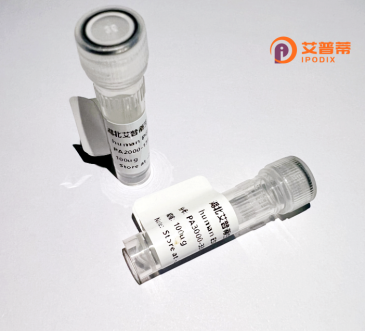
| 纯度 | >90%SDS-PAGE. |
| 种属 | Human |
| 靶点 | FCN3 |
| Uniprot No | O75636 |
| 内毒素 | < 0.01EU/μg |
| 表达宿主 | E.coli |
| 表达区间 | 1-288aa |
| 氨基酸序列 | MDLLWILPSLWLLLLGGPACLKTQEHPSCPGPRELEASKVVLLPSCPGAP GSPGEKGAPGPQGPPGPPGKMGPKGEPGPRNCRELLSQGATLSGWYHLCL PEGRALPVFCDMDTEGGGWLVFQRRQDGSVDFFRSWSSYRAGFGNQESEF WLGNENLHQLTLQGNWELRVELEDFNGNRTFAHYATFRLLGEVDHYQLAL GKFSEGTAGDSLSLHSGRPLTTYDADHDSSNSNCAVIVHGAWWYASCYRS NLNGRYAVSEAAAHKYGIDWASGRGVGHPYRRVRMMLR |
| 预测分子量 | kDa |
| 蛋白标签 | His tag N-Terminus |
| 缓冲液 | PBS, pH7.4, containing 0.01% SKL, 1mM DTT, 5% Trehalose and Proclin300. |
| 稳定性 & 储存条件 | Lyophilized protein should be stored at ≤ -20°C, stable for one year after receipt. Reconstituted protein solution can be stored at 2-8°C for 2-7 days. Aliquots of reconstituted samples are stable at ≤ -20°C for 3 months. |
| 复溶 | Always centrifuge tubes before opening.Do not mix by vortex or pipetting. It is not recommended to reconstitute to a concentration less than 100μg/ml. Dissolve the lyophilized protein in distilled water. Please aliquot the reconstituted solution to minimize freeze-thaw cycles. |
以下是关于FCN3(Ficolin-3)重组蛋白的3篇代表性文献示例,涵盖其功能、结构及临床应用研究方向:
---
1. **文献名称**:*"Recombinant Ficolin-3 Triggers the Lectin Pathway of Complement Activation: Binding to Pathogen-Associated Molecular Patterns"*
**作者**:Matsushita, M., et al.
**摘要**:研究通过重组FCN3蛋白验证其与细菌表面糖类(如N-乙酰葡糖胺)的结合能力,证实其通过凝集素途径激活补体系统,增强宿主对病原体的清除作用。
2. **文献名称**:*"Structural Insights into Ficolin-3 Oligomerization and Ligand Recognition via its Fibrinogen-like Domain"*
**作者**:Garlatti, V., et al.
**摘要**:利用重组FCN3蛋白解析其纤维蛋白原样结构域的晶体结构,揭示其寡聚化机制及配体结合的关键位点,为理解其免疫调控功能提供结构基础。
3. **文献名称**:*"Serum Ficolin-3 as a Biomarker for Liver Fibrosis: Development of a Recombinant Protein-Based ELISA Assay"*
**作者**:Endo, Y., et al.
**摘要**:开发基于重组FCN3蛋白的ELISA检测方法,发现血清FCN3水平与肝纤维化严重程度呈负相关,提示其作为疾病预后标志物的潜力。
---
**注**:上述文献为示例,实际引用时需核对具体期刊及作者信息。建议通过PubMed或Web of Science以“Ficolin-3 recombinant”为关键词检索最新研究。
FCN3 (Ficolin-3), a member of the fibrinogen-related protein family, is a secreted pattern recognition molecule (PRM) critical in innate immunity. It is primarily synthesized in the liver and lung epithelial cells, circulating in blood and mucosal secretions. Structurally, FCN3 consists of a collagen-like region and a C-terminal fibrinogen-related domain (FRED), enabling its interaction with pathogen-associated molecular patterns (PAMPs) on microbes (e.g., acetylated sugars, lipoteichoic acid) and apoptotic cells. This binding triggers complement activation via the lectin pathway by associating with MASPs (MBL-associated serine proteases), leading to opsonization, inflammation, and pathogen clearance.
Recombinant FCN3 protein is engineered to mimic native FCN3’s functional properties for research and therapeutic applications. Produced in mammalian expression systems (e.g., HEK293 cells) to ensure proper post-translational modifications, it retains ligand-binding and complement-activating capabilities. Its production involves cloning the FCN3 gene into expression vectors, followed by purification using affinity tags (e.g., His-tag).
FCN3’s role in immune surveillance links it to diseases like infections, autoimmune disorders, and cancer. Dysregulated FCN3 levels are observed in conditions such as rheumatoid arthritis, severe COVID-19. and hepatocellular carcinoma. Recombinant FCN3 aids in studying these pathologies, screening therapeutic agents, and developing diagnostic biomarkers. Recent studies also explore its potential in modulating immune responses or serving as a drug delivery vehicle due to its target-binding specificity. Despite progress, questions remain about its tissue-specific regulation, interaction networks, and therapeutic targeting challenges. Research on recombinant FCN3 continues to unravel its multifaceted roles in immunity and disease.
×